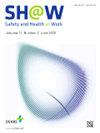职业辐射照射癌症风险评估中生活方式因素的混杂效应
IF 2.9
3区 医学
Q1 PUBLIC, ENVIRONMENTAL & OCCUPATIONAL HEALTH
引用次数: 0
摘要
生活方式因素的混杂效应在职业研究中是一个重要的问题,特别是当风险幅度相对较小时。本研究旨在评估生活方式因素对辐射暴露与癌症发病率之间关系的潜在混杂效应。方法将在国家剂量登记处登记的所有韩国诊断医疗放射工作人员的数据与截至2018年的癌症发病率记录合并。使用泊松回归模型计算癌症的过量相对危险度(ERRs),以量化辐射剂量-反应关系。以调查数据为基础,采用链式方程对主要生活方式因素进行多重拟合。通过比较调整生活方式因素前后的ERRs来评估混杂效应。结果在调整了达到的年龄、性别、出生年份和工作时间后,每西弗癌症发生率的基线ERR为0.44 (95% CI: -0.94, 1.83)。进一步调整生活方式因素(吸烟状况、饮酒、体重指数、体育锻炼、睡眠时间和夜班工作)并没有实质性地改变这一风险系数,估计值的变化范围为0%至13.6%。采用基于调查的队列和性别分层分析进行的敏感性分析得出了一致的结果。结论我们的研究发现,当对医疗放射工作者的基本登记数据变量进行调整时,没有证据表明未测量的生活方式因素对癌症风险有显著的混淆作用。有必要进一步研究未测量和未知混杂因素的影响,以提高辐射风险估计的准确性。本文章由计算机程序翻译,如有差异,请以英文原文为准。
Confounding Effects of Lifestyle Factors in Cancer Risk Estimation for Occupational Radiation Exposure
Background
The confounding effect of lifestyle factors is an important concern in occupational studies, particularly when the risk magnitude is relatively small. This study aimed to evaluate the potential confounding effects of lifestyle factors on the association between radiation exposure and cancer incidence.
Methods
Data from all Republic of Korean diagnostic medical radiation workers enrolled in the national dose registry were merged with cancer incidence records up to 2018. Excess relative risks (ERRs) for cancer were calculated using Poisson regression models to quantify the radiation dose-response relationship. Major lifestyle factors were imputed using multiple imputations by chained equations based on survey data. The confounding effects were assessed by comparing ERRs before and after adjustment for lifestyle factors.
Results
The baseline ERR for cancer incidence per Sievert was 0.44 (95% CI: -0.94, 1.83) after adjusting for attained age, sex, birth year, and employment duration. Further adjustment for lifestyle factors (smoking status, alcohol consumption, body mass index, physical exercise, sleep duration, and night shift work) did not substantially modify this risk coefficient, with change-in-estimate values ranging from 0% to 13.6%. Sensitivity analyses conducted with the survey-based cohort and sex-stratified analyses yielded consistent results.
Conclusion
Our study found little evidence of significant confounding effects from unmeasured lifestyle factors on cancer risk when basic registry data variables were adjusted among medical radiation workers. Further studies are warranted to investigate the impact of unmeasured and unknown confounders to improve the accuracy of radiation risk estimates.
求助全文
通过发布文献求助,成功后即可免费获取论文全文。
去求助
来源期刊

Safety and Health at Work
Social Sciences-Safety Research
CiteScore
6.40
自引率
5.70%
发文量
1080
审稿时长
38 days
期刊介绍:
Safety and Health at Work (SH@W) is an international, peer-reviewed, interdisciplinary journal published quarterly in English beginning in 2010. The journal is aimed at providing grounds for the exchange of ideas and data developed through research experience in the broad field of occupational health and safety. Articles may deal with scientific research to improve workers'' health and safety by eliminating occupational accidents and diseases, pursuing a better working life, and creating a safe and comfortable working environment. The journal focuses primarily on original articles across the whole scope of occupational health and safety, but also welcomes up-to-date review papers and short communications and commentaries on urgent issues and case studies on unique epidemiological survey, methods of accident investigation, and analysis. High priority will be given to articles on occupational epidemiology, medicine, hygiene, toxicology, nursing and health services, work safety, ergonomics, work organization, engineering of safety (mechanical, electrical, chemical, and construction), safety management and policy, and studies related to economic evaluation and its social policy and organizational aspects. Its abbreviated title is Saf Health Work.
 求助内容:
求助内容: 应助结果提醒方式:
应助结果提醒方式:


